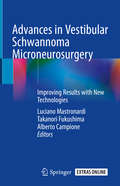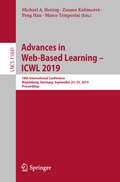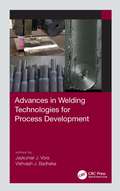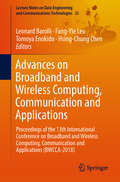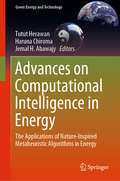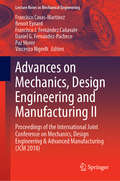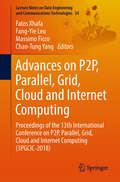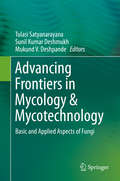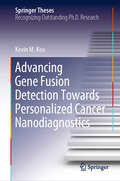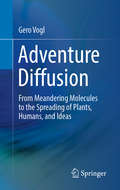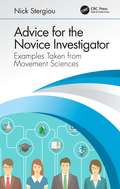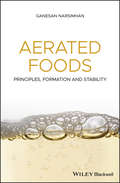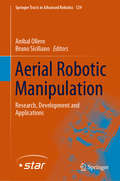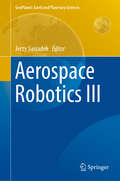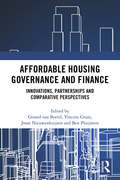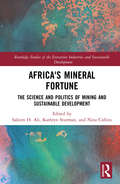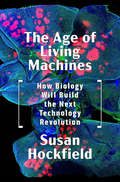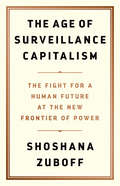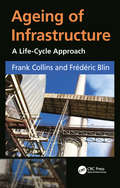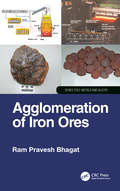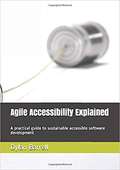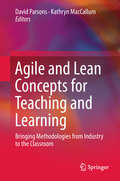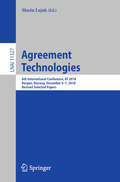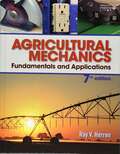- Table View
- List View
Advances in Vestibular Schwannoma Microneurosurgery: Improving Results With New Technologies
by Luciano Mastronardi Takanori Fukushima Alberto CampioneThis volume describes the most relevant and cutting-edge technological news on the complex surgical procedure of acoustic neuroma. The clinical-radiological diagnosis and surgical indications are briefly presented and the surgical technique is illustrated step-by-step: video clips show the latest means of treating these patients. All these indications were prepared by highly experienced experts in the field, based on their personal experience. The new technologies discussed concern e.g. the intraoperative identification and position of the facial nerve, hearing preservation, techniques for dural closure, and the usefulness of laser and ultrasound aspirators. The book also discusses a number of ongoing projects, including those on: diluted papaverine for microvascular protection of cranial nerves, flexible endoscope for IAC control of tumor removal, fluid cement for bone closure, administering aspirin to control residual tumors larger than 7mm, and DTI for preoperative prediction of the position of the facial nerve. This is a highly informative presented book providing surgeon interested in acoustic neuroma with necessary information on modern technologies available for improving the results of patients.
Advances in Web-Based Learning – ICWL 2019: 18th International Conference, Magdeburg, Germany, September 23–25, 2019, Proceedings (Lecture Notes in Computer Science #11841)
by Marco Temperini Michael A. Herzog Zuzana Kubincová Peng HanThis book constitutes the proceedings of the 18th International Conference on Advances in Web-Based Learning, ICWL 2019, held in Magdeburg, Germany, in September 2019. The 15 full, 15 short, and 7 poster papers presented in this volume were carefully reviewed and selected from 68 submissions. The contributions were organized in topical sections named: Semantic Web for E-Learning, Learning Analytics, Computer Supported Collaborative Learning, Assessment and Pedagogical Issues, E-learning Platforms and Tools, Mobile Learning, and Poster Papers.
Advances in Welding Technologies for Process Development
by Jaykumar Vora Vishvesh J. BadhekaWithin manufacturing, welding is by far the most widely used fabrication method used for production, leading to a rise in research and development activities pertaining to the welding and joining of different, similar, and dissimilar combinations of the metals. This book addresses recent advances in various welding processes across the domain, including arc welding and solid-state welding process, as well as experimental processes. The content is structured to update readers about the working principle, predicaments in existing process, innovations to overcome these problems, and direct industrial and practical applications. Key Features: Describes recent developments in welding technology, engineering, and science Discusses advanced computational techniques for procedure development Reviews recent trends of implementing DOE and meta-heuristics optimization techniques for setting accurate parameters Addresses related theoretical, practical, and industrial aspects Includes all the aspects of welding, such as arc welding, solid state welding, and weld overlay
Advances on Broadband and Wireless Computing, Communication and Applications: Proceedings of the 13th International Conference on Broadband and Wireless Computing, Communication and Applications (BWCCA-2018) (Lecture Notes on Data Engineering and Communications Technologies #25)
by Leonard Barolli Fang-Yie Leu Tomoya Enokido Hsing-Chung ChenThis book presents on the latest research findings, and innovative research methods and development techniques related to the emerging areas of broadband and wireless computing from both theoretical and practical perspectives.Information networking is evolving rapidly with various kinds of networks with different characteristics emerging and being integrated into heterogeneous networks. As a result, a number of interconnection problems can occur at different levels of the communicating entities and communication networks’ hardware and software design. These networks need to manage an increasing usage demand, provide support for a significant number of services, guarantee their QoS, and optimize the network resources. The success of all-IP networking and wireless technology has changed the way of life for people around the world, and the advances in electronic integration and wireless communications will pave the way for access to the wireless networks on the fly. This in turn means that all electronic devices will be able to exchange the information with each other in a ubiquitous way whenever necessary.
Advances on Computational Intelligence in Energy: The Applications of Nature-Inspired Metaheuristic Algorithms in Energy (Green Energy and Technology)
by Tutut Herawan Haruna Chiroma Jemal H. AbawajyAddressing the applications of computational intelligence algorithms in energy, this book presents a systematic procedure that illustrates the practical steps required for applying bio-inspired, meta-heuristic algorithms in energy, such as the prediction of oil consumption and other energy products. Contributions include research findings, projects, surveying work and industrial experiences that describe significant advances in the applications of computational intelligence algorithms in energy. For easy understanding, the text provides practical simulation results, convergence and learning curves as well as illustrations and tables. Providing a valuable resource for undergraduate and postgraduate students alike, it is also intended for researchers in the fields of computational intelligence and energy.
Advances on Mechanics, Design Engineering and Manufacturing II: Proceedings of the International Joint Conference on Mechanics, Design Engineering & Advanced Manufacturing (JCM 2018) (Lecture Notes in Mechanical Engineering)
by Francisco Cavas-Martínez Benoit Eynard Francisco J. Fernández Cañavate Daniel G. Fernández-Pacheco Paz Morer Vincenzo NigrelliThis book contains the papers presented at the International Joint Conference on Mechanics, Design Engineering and Advanced Manufacturing (JCM 2018), held on 20-22 June 2018 in Cartagena, Spain. It reports on cutting-edge topics in product design and manufacturing, such as industrial methods for integrated product and process design; innovative design; and computer-aided design. Further topics covered include virtual simulation and reverse engineering; additive manufacturing; product manufacturing; engineering methods in medicine and education; representation techniques; and nautical, aeronautics and aerospace design and modeling. The book is divided into six main sections, reflecting the focus and primary themes of the conference. The contributions presented here will not only provide researchers, engineers and experts in a range of industrial engineering subfields with extensive information to support their daily work; they are also intended to stimulate new research directions, advanced applications of the methods discussed, and future interdisciplinary collaborations.
Advances on P2P, Parallel, Grid, Cloud and Internet Computing: Proceedings of the 13th International Conference on P2P, Parallel, Grid, Cloud and Internet Computing (3PGCIC-2018) (Lecture Notes on Data Engineering and Communications Technologies #24)
by Fatos Xhafa Fang-Yie Leu Massimo Ficco Chao-Tung YangThis book presents the latest research findings, as well as innovative theoretical and practical research results, methods and development techniques related to P2P, grid, cloud and Internet computing. It also reveals the synergies among such large scale computing paradigms. P2P, Grid, Cloud and Internet computing technologies have rapidly become established as breakthrough paradigms for solving complex problems by enabling aggregation and sharing of an increasing variety of distributed computational resources on a large scale. Grid computing originated as a paradigm for high-performance computing, offering an alternative to expensive supercomputers through different forms of large-scale distributed computing. P2P computing emerged as a new paradigm following on from client-server and web-based computing and has proved useful in the development of social networking, B2B (Business to Business), B2C (Business to Consumer), B2G (Business to Government), and B2E (Business to Employee). Cloud computing has been described as a “computing paradigm where the boundaries of computing are determined by economic rationale rather than technical limits”. Cloud computing has fast become the computing paradigm with applicability and adoption in all domains and providing utility computing at large scale. Lastly, Internet computing is the basis of any large-scale distributed computing paradigm; it has very quickly developed into a vast and flourishing field with enormous impact on today’s information societies and serving as a universal platform comprising a large variety of computing forms such as grid, P2P, cloud and mobile computing.
Advancing Frontiers in Mycology & Mycotechnology: Basic and Applied Aspects of Fungi
by Tulasi Satyanarayana Sunil Kumar Deshmukh Mukund V. DeshpandeThe book provides an introduction to the basics of fungi, discussing various types ranging from edible mushrooms to Neurospora – a model system for genetics and epigenetics. After addressing the classification and biodiversity of fungi, and fungi in different ecological niches, it describes the latest applications of fungi, their role in sustainable environments and in alleviating stress in plants, as well as their role in causing plant and animal diseases. Further chapters explore the advances in fungal interactions research and their implications for various systems, and discuss plant-pathogen interactions. The book also features a section on bioprospecting, and is an extremely interesting and informative read for anybody involved in the field of mycology, microbiology and biotechnology teaching and research.
Advancing Gene Fusion Detection Towards Personalized Cancer Nanodiagnostics (Springer Theses)
by Kevin M. KooThis book presents a unique concept of merging nanotechnology and novel urinary biomarkers for accurate early prostate cancer detection, discussing an entire progressive pipeline of innovative new strategies in biosensor development, from a simple colorimetric system to a complex system for simultaneous multiple biomarker sensing. For newcomers to the field of nucleic acid biosensing, it also describes various isothermal amplification and amplification-free strategies, which are currently the main research areas. Lastly, the book introduces and demonstrates the notion of clinical nanobiosensor validation toward clinical translation: the ultimate aim of researchers in the biosensor field. This book is a valuable reference resource learners seeking inspiration for cancer biosensor development.
Adventure Diffusion: From Meandering Molecules to the Spreading of Plants, Humans, and Ideas
by Gero VoglThis easy-to read book looks at the many ways in which diffusion bears on processes that involve dispersion, starting from the Brownian motion of molecules, covering the invasion of exotic plants, migration of populations, epidemics, and extending to the spreading of languages and ideas. Recently, there has been a growing interest in understanding migrations, diffusion and spreading outside the “hard” natural sciences of physics and chemistry, for example the spreading of plants introduced as a result of globalization. Another fascinating story is that of human migration in the distant past, i.e. the immigration of our ancestors who brought agriculture from the Near East, or the fast spread of the Palaeo-Indians into the Americas after the end of the Ice Age. Likewise, the spread of languages in the past, and even more so the current spread and retreat of languages will be described here in terms of diffusion. By understanding these principles, there is hope that some of the less common languages that are threatened by globalization can be saved. Another important implication discussed by the author concerns the outbreak of epidemics; these may be mitigated if we understand their spreading mechanism. Last but not least the spreading of ideas and innovations, a process which changes the world sometimes faster than we wish, can also be usefully described in this picture.
Advice for the Novice Investigator: Examples Taken from Movement Sciences
by Nick StergiouThis book is intended to help young and novice scientists by providing them with advice on how to overcome adversities. This advice comes in the form of numerous examples from the author’s career but also from the careers of many other scientists. It follows the thinking process of Ramon Y Cajal and his famous book, "Advice for a Young Investigator." It covers a variety of topics and areas that are fundamental in becoming a successful scientist. It presents chapters on all essential areas of the scientific life that appeal to a wide range of audiences, from the senior undergraduate student to the university administrator to the chief scientist in the industry. Some figures in the eBook are in color. Features Contains practical advice and many hints on a variety of topics; from how to write a grant to how to effectively manage your time Displays many examples of success and failure from other scientists that can teach valuable lessons Provides many personal stories and anecdotes in a form of sincere confessions Includes PowerPoint Presentation slides for each chapter for any academicians that want to develop such a class in their institutions
Aerated Foods: Principles, Formation and Stability
by Ganesan NarsimhanExplore the roles aeration can play in the production, stability, and consumer experience of foods Aeration is an increasingly prevalent part of food manufacturing, bringing a light texture, enhanced appearance, and richer flavors to a wide range of products. Essential to the creation of everything from ice cream and popcorn to cheese and beer, the incorporation of fine air bubbles into the foods we consume can also boost satiety and thus reduce calorific intake. Aerated Foods examines this process in detail, offering a complete overview of all aspects of aeration. With sections that address the effects of aeration upon product structure and stability, this informative book explains how food formulation influences the shelf life, texture, and overall experience of different foods. Chapters also outline the various methods by which aeration can be achieved, breaking down the science and technology involved in the incorporation of air Details the mechanisms and overall results of aeration as a method of food processing Covers innovative and experimental aeration techniques Looks at the role of aeration in baking Aerated Foods provides food scientists, researchers, and product developers with an invaluable guide to this multifaceted and fast-growing method of food production.
Aerial Robotic Manipulation: Research, Development and Applications (Springer Tracts in Advanced Robotics #129)
by Anibal Ollero Bruno SicilianoAerial robotic manipulation integrates concepts and technologies coming from unmanned aerial systems and robotics manipulation. It includes not only kinematic, dynamics, aerodynamics and control but also perception, planning, design aspects, mechatronics and cooperation between several aerial robotics manipulators. All these topics are considered in this book in which the main research and development approaches in aerial robotic manipulation are presented, including the description of relevant systems. In addition of the research aspects, the book also includes the deployment of real systems both indoors and outdoors, which is a relevant characteristic of the book because most results of aerial robotic manipulation have been validated only indoor using motion tracking systems. Moreover, the book presents two relevant applications: structure assembly and inspection and maintenance, which has started to be applied in the industry. The Chapters of the book will present results of two main European Robotics Projects in aerial robotics manipulation: FP7 ARCAS and H2020 AEROARMS. FP7 ARCAS defined the basic concepts on aerial robotic manipulation, including cooperative manipulation. The H2020 AEROARMS on aerial robot with multiple arms and advanced manipulation capabilities for inspection and maintenance has two general objectives: (1) development of advanced aerial robotic manipulation methods and technologies, including manipulation with dual arms and multi-directional thrusters aerial platforms; and (2) application to the inspection and maintenance.
The Aeronauts: Travels in the Air
by James GlaisherThe True Story Behind the Major Motion Picture — and one of the greatest daredevil stories in the history of aviationIn 1862, ambitious scientist James Glaisher set out to do the impossible: ascend higher into the skies than ever before. A pioneer of weather forecasting and of photography, and a founding member of the Royal Meteorological Society, he wanted to take ground-breaking research measurements from different altitudes. On 5th September, along with experienced balloonist Henry Coxwell as his pilot, he lifted off in a hot air balloon for what would prove to be a death-defying and historic flight. Rising above the English countryside, they rose to the remarkable height of 37,000 feet (7 miles or 11km), almost killing both men, who experienced blurred vision, loss of motor function and, eventually, unconsciousness. It was a miracle they survived to tell the tale. Written in his own words, The Aeronauts chronicles Glaisher’s incredible flights and discoveries first hand, as well as his observations on those pioneers who came before and inspired him. His audaciously daring journey forms the story of the forthcoming major motion picture The Aeronauts. With an introduction by Professor Liz Bentley, Chief Executive at the Royal Meteorological Society
Aerospace Robotics III (GeoPlanet: Earth and Planetary Sciences)
by Jerzy SasiadekThis book includes extended versions of original works on aerospace robotics presented at the Conference on Aerospace Robotics (CARO) in Warsaw. It presents recent advances in aerospace robotics, such as manipulators, which are widely used in space for orbital operations, for example, the Mobile Servicing System on the International Space Station and the Shuttle Remote Manipulator System. Such manipulators are operated by astronauts and mounted on large platforms, making the influence of manipulator motion on the state of the platform insignificant. Application of manipulators for capture maneuvers in unmanned On-Orbit Servicing or Active Debris Removal missions requires reliable control algorithms that take into account the free-floating nature of the manipulator-equipped spacecraft. As such the book presents possibilities for using space manipulators for exploration and a variety of space operations. Further, it discusses new methods for the control of autonomous unmanned aerial vehicles (UAV) using vision systems and sensor fusion methodologies. Such autonomous flying vehicles could be used for materials deliveries and emergencies, as well as surveying and servicing.
Affordable Housing Governance and Finance: Innovations, partnerships and comparative perspectives
by Gerard Bortel Vincent Gruis Joost Nieuwenhuijzen Ben PluijmersThere is a large shortage of affordable housing across Europe. In high‐demand urban areas housing shortages lead to unaffordable prices for many target groups. This book explores innovations to support a sufficient supply of affordable and sustainable rental housing. Affordable housing is increasingly developed, financed and managed by a mix of market, state, third sector and community actors. Recent decades in large parts of the Western world have consecutively shown state-dominated, non-profit housing sectors, an increased role for market forces and the private sector, and the rise of initiatives by citizens and local communities. The variety of hybrid governance and finance arrangements is predicted to increase further, leading to new affordable housing delivery and management models. This book explores these innovations, with a focus on developments across Europe, and comparative chapters from the USA and Australia. The book presents new thinking in collaborative housing, co-production and accompanying finance mechanisms in order to support the quantity and the quality of affordable rental housing. Combining academic robustness with practical relevance, chapters are written by renowned housing researchers in collaboration with practitioners from the housing sector. The book not only presents, compares and contrasts affordable housing solutions, but also explores the transferability of innovations to other countries. The book is essential reading for researchers and professionals in housing, social policy, urban planning and finance.
Africa's Mineral Fortune: The Science and Politics of Mining and Sustainable Development (Routledge Studies of the Extractive Industries and Sustainable Development)
by Saleem H. Ali Kathryn Sturman Nina CollinsFor too long Africa's mineral fortune has been lamented as a resource curse that has led to conflict rather than development for much of the continent. Yet times are changing and the opportunities to bring technical expertise on modern mining alongside appropriate governance mechanisms for social development are becoming more accessible in Africa. This book synthesizes perspectives from multiple disciplines to address Africa’s development goals in relation to its mineral resources. The authors cover ways of addressing a range of policy challenges, environmental concerns, and public health impacts and also consider the role of globalization within the extractive industries. Academic research is coupled with key field vignettes from practitioners exemplifying case studies throughout. The book summarizes the challenges of natural resource governance, suggesting ways in which mining can be more effectively managed in Africa. By providing an analytical framework it highlights the essential intersection between natural and social sciences, central to efficient and effective harnessing of the potential for minerals and mining to be a contributor to positive development in Africa. It will be of interest to policy makers, industry professionals, and researchers in the extractive industries, as well as to the broader development community.
The Age of Living Machines: How Biology Will Build The Next Technology Revolution
by Susan HockfieldFrom the former president of MIT, the story of the next technology revolution, and how it will change our lives. A century ago, discoveries in physics came together with engineering to produce an array of astonishing new technologies: radios, telephones, televisions, aircraft, radar, nuclear power, computers, the Internet, and a host of still-evolving digital tools. These technologies so radically reshaped our world that we can no longer conceive of life without them. Today, the world’s population is projected to rise to well over 9.5 billion by 2050, and we are currently faced with the consequences of producing the energy that fuels, heats, and cools us. With temperatures and sea levels rising, and large portions of the globe plagued with drought, famine, and drug-resistant diseases, we need new technologies to tackle these problems. But we are on the cusp of a new convergence, argues world-renowned neuroscientist Susan Hockfield, with discoveries in biology coming together with engineering to produce another array of almost inconceivable technologies—next-generation products that have the potential to be every bit as paradigm shifting as the twentieth century’s digital wonders. The Age of Living Machines describes some of the most exciting new developments and the scientists and engineers who helped create them. Virus-built batteries. Protein-based water filters. Cancer-detecting nanoparticles. Mind-reading bionic limbs. Computer-engineered crops. Together they highlight the promise of the technology revolution of the twenty-first century to overcome some of the greatest humanitarian, medical, and environmental challenges of our time.
The Age of Surveillance Capitalism: The Fight for a Human Future at the New Frontier of Power
by Shoshana ZuboffThe challenges to humanity posed by the digital future, the first detailed examination of the unprecedented form of power called "surveillance capitalism," and the quest by powerful corporations to predict and control our behavior. <P><P>Shoshana Zuboff's interdisciplinary breadth and depth enable her to come to grips with the social, political, business, and technological meaning of the changes taking place in our time. We are at a critical juncture in the confrontation between the vast power of giant high-tech companies and government, the hidden economic logic of surveillance capitalism, and the propaganda of machine supremacy that threaten to shape and control human life. <P><P>Will the brazen new methods of social engineering and behavior modification threaten individual autonomy and democratic rights and introduce extreme new forms of social inequality? Or will the promise of the digital age be one of individual empowerment and democratization? <P><P>The Age of Surveillance Capitalism is neither a hand-wringing narrative of danger and decline nor a digital fairy tale. Rather, it offers a deeply reasoned and evocative examination of the contests over the next chapter of capitalism that will decide the meaning of information civilization in the twenty-first century. The stark issue at hand is whether we will be the masters of information and machines or its slaves.
Ageing of Infrastructure: A Life-Cycle Approach
by Frank Collins Frédéric BlinThe book addresses the problem of ageing infrastructure and how ageing can reduce the service life below expected levels. The rate of ageing is affected by the type of construction material, environmental exposure, function of the infrastructure, and loading: each of these factors is considered in the assessment of ageing. How do international design codes address ageing? Predictive models of ageing behaviour are available and the different types (empirical, deterministic, and probabilistic) are discussed in a whole-of-life context. Life cycle plans, initiated at the design stage, can ensure that the design life is met, while optimising the management of the asset: reducing life cycle costs and reducing the environmental footprint due to less maintenance/remediation interventions and fewer unplanned stoppages and delays. Health monitoring of infrastructure can be conducted via implanted probes (wired or wireless) or by non-destructive testing that can routinely measure the durability, loading, and exposure environments at key locations around the facility. Routine monitoring can trigger preventative maintenance that can extend the life of the infrastructure and minimise unplanned and reactive remediation, while also providing ongoing data that can be utilised towards more durable future construction. Future infrastructure will need to be safe and durable, financially and environmentally sustainable over the lifecycle, thereby raising socio-economic wellbeing. The book concludes by discussing the key impacting factors that will need to be addressed. The author brings a strong academic and industry background to present a resource for academics and practitioners wishing to address the ageing of built infrastructure.
Agglomeration of Iron Ores (Metals And Alloys Ser.)
by Ram Pravesh BhagatThis book focuses on agglomeration, or the size enlargement process, of iron ores. This process sits at the interface of mineral processing and extractive metallurgy. The book begins with a discussion of raw materials preparation and the beneficiation process. It then describes fundamental principles of the sintering and pelletization processes, including formation of green mix through granulation and green balls as well as chemical reactions during sintering. Finally, it offers a brief description of iron making processes and correlations related to the agglomerates: quality parameters and BF productivity and coke rate.
Agile Accessibility Explained: A Practical Guide to Sustainable Accessible Software Development
by Dylan A. BarrellYears of experience down in the trenches of accessibility remediation projects, driven by lawsuits related to the Americans with Disabilities Act (ADA) or laws like the Accessibility for Ontarians with Disabilities Act (AODA) in Canada have given Mr. Barrell experience as to the practices that work when implementing sustainable accessible software development. He has collected these together in a very practical guide on how to do agile accessible development that goes from the design and usability phase all the way through to deployment. On the way it deals with continuous integration and delivery, issue tracking, testing and coding as well as the organizational practices required to support the individual agile teams. A must read for anyone who takes accessibility seriously.
Agile and Lean Concepts for Teaching and Learning: Bringing Methodologies from Industry to the Classroom
by David Parsons Kathryn MacCallumThis book explores the application of agile and lean techniques, originally from the field of software development and manufacturing, to various aspects of education. It covers a broad range of topics, including applying agile teaching and learning techniques in the classroom, incorporating lean thinking in educational workflows, and using team-based approaches to student-centred activities based on agile principles and processes.Demonstrating how agile and lean ideas can concretely be applied to education, the book offers practical guidance on how to apply these ideas in the classroom or lecture hall, as well as new concepts that could spark further research and development.
Agreement Technologies: 6th International Conference, At 2018, Bergen, Norway, December 6-7, 2018, Revised Selected Papers (Lecture Notes in Computer Science #11327)
by Marin LujakThis book constitutes the revised selected papers from the 6th International Conference on Agreement Technologies, AT 2018, held in Bergen, Norway, in December 2018. The 11 full papers and 6 short papers presented in this volume were carefully reviewed and selected from a total of 28 submissions. The papers discuss new ideas and techniques for the design, implementation and verification of next generation open distributed systems centered on the notion of agreement among computational agents. They are organized in the following topical sections: AT foundations and modelling of reasoning agents; argumentation and negotiation; coordination in open distributed systems with applications.
Agricultural Mechanics: Fundamentals and Applications, Updated: Precision Exams Edition
by Ray V. HerrenBeyond providing a thorough introduction to the field of agricultural mechanics, the Precision Exams Edition of this trusted text aligns to Precision Exams Agricultural Systems Technology, Level 1 exam. The text covers fundamental mechanical and engineering theory, common tools and materials, and practical applications including shop orientation and procedures, woodworking and metalworking, tool fitting, project planning, cutting and welding, paints and paint application, power mechanics, electrical wiring, plumbing, hydraulics, concrete and masonry, and agricultural structures. Safety is also emphasized strongly throughout the text, and a dedicated unit introduces students to diverse career opportunities. The current edition also features new information on the National FFA Organization and SAEs, first aid, and engine powered equipment, as well as new activities and lab exercises.
